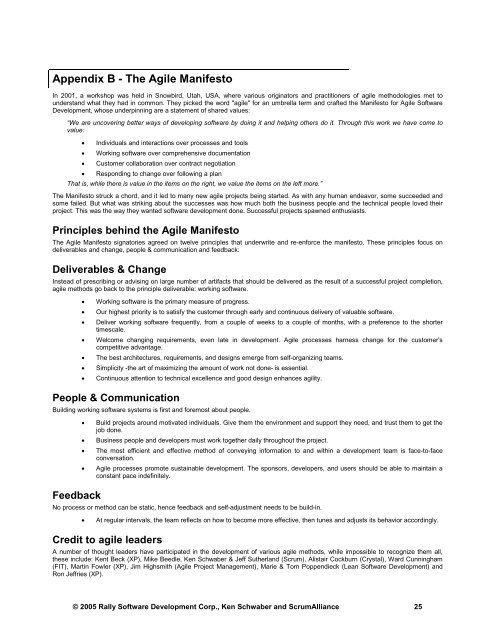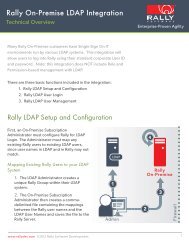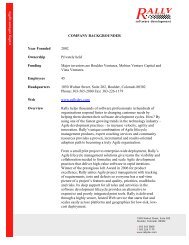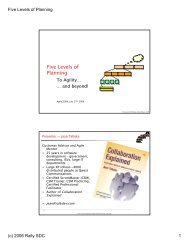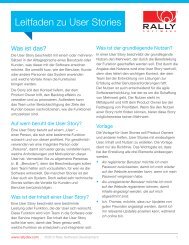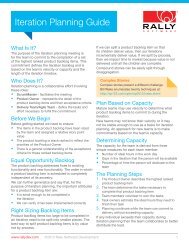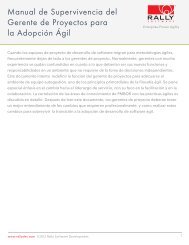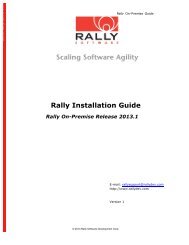A CIO's Playbook for Adopting the Scrum Method of ... - Rally Software
A CIO's Playbook for Adopting the Scrum Method of ... - Rally Software
A CIO's Playbook for Adopting the Scrum Method of ... - Rally Software
You also want an ePaper? Increase the reach of your titles
YUMPU automatically turns print PDFs into web optimized ePapers that Google loves.
Appendix B - The Agile ManifestoIn 2001, a workshop was held in Snowbird, Utah, USA, where various originators and practitioners <strong>of</strong> agile methodologies met tounderstand what <strong>the</strong>y had in common. They picked <strong>the</strong> word "agile" <strong>for</strong> an umbrella term and crafted <strong>the</strong> Manifesto <strong>for</strong> Agile S<strong>of</strong>twareDevelopment, whose underpinning are a statement <strong>of</strong> shared values:“We are uncovering better ways <strong>of</strong> developing s<strong>of</strong>tware by doing it and helping o<strong>the</strong>rs do it. Through this work we have come tovalue:Individuals and interactions over processes and toolsWorking s<strong>of</strong>tware over comprehensive documentationCustomer collaboration over contract negotiationResponding to change over following a planThat is, while <strong>the</strong>re is value in <strong>the</strong> items on <strong>the</strong> right, we value <strong>the</strong> items on <strong>the</strong> left more.”The Manifesto struck a chord, and it led to many new agile projects being started. As with any human endeavor, some succeeded andsome failed. But what was striking about <strong>the</strong> successes was how much both <strong>the</strong> business people and <strong>the</strong> technical people loved <strong>the</strong>irproject. This was <strong>the</strong> way <strong>the</strong>y wanted s<strong>of</strong>tware development done. Successful projects spawned enthusiasts.Principles behind <strong>the</strong> Agile ManifestoThe Agile Manifesto signatories agreed on twelve principles that underwrite and re-en<strong>for</strong>ce <strong>the</strong> manifesto. These principles focus ondeliverables and change, people & communication and feedback:Deliverables & ChangeInstead <strong>of</strong> prescribing or advising on large number <strong>of</strong> artifacts that should be delivered as <strong>the</strong> result <strong>of</strong> a successful project completion,agile methods go back to <strong>the</strong> principle deliverable: working s<strong>of</strong>tware.Working s<strong>of</strong>tware is <strong>the</strong> primary measure <strong>of</strong> progress.Our highest priority is to satisfy <strong>the</strong> customer through early and continuous delivery <strong>of</strong> valuable s<strong>of</strong>tware.Deliver working s<strong>of</strong>tware frequently, from a couple <strong>of</strong> weeks to a couple <strong>of</strong> months, with a preference to <strong>the</strong> shortertimescale.Welcome changing requirements, even late in development. Agile processes harness change <strong>for</strong> <strong>the</strong> customer'scompetitive advantage.The best architectures, requirements, and designs emerge from self-organizing teams.Simplicity -<strong>the</strong> art <strong>of</strong> maximizing <strong>the</strong> amount <strong>of</strong> work not done- is essential.Continuous attention to technical excellence and good design enhances agility.People & CommunicationBuilding working s<strong>of</strong>tware systems is first and <strong>for</strong>emost about people.Build projects around motivated individuals. Give <strong>the</strong>m <strong>the</strong> environment and support <strong>the</strong>y need, and trust <strong>the</strong>m to get <strong>the</strong>job done.Business people and developers must work toge<strong>the</strong>r daily throughout <strong>the</strong> project.The most efficient and effective method <strong>of</strong> conveying in<strong>for</strong>mation to and within a development team is face-to-faceconversation.Agile processes promote sustainable development. The sponsors, developers, and users should be able to maintain aconstant pace indefinitely.FeedbackNo process or method can be static, hence feedback and self-adjustment needs to be build-in.At regular intervals, <strong>the</strong> team reflects on how to become more effective, <strong>the</strong>n tunes and adjusts its behavior accordingly.Credit to agile leadersA number <strong>of</strong> thought leaders have participated in <strong>the</strong> development <strong>of</strong> various agile methods, while impossible to recognize <strong>the</strong>m all,<strong>the</strong>se include: Kent Beck (XP), Mike Beedle, Ken Schwaber & Jeff Su<strong>the</strong>rland (<strong>Scrum</strong>), Alistair Cockburn (Crystal), Ward Cunningham(FIT), Martin Fowler (XP), Jim Highsmith (Agile Project Management), Marie & Tom Poppendieck (Lean S<strong>of</strong>tware Development) andRon Jeffries (XP).© 2005 <strong>Rally</strong> S<strong>of</strong>tware Development Corp., Ken Schwaber and <strong>Scrum</strong>Alliance 25


